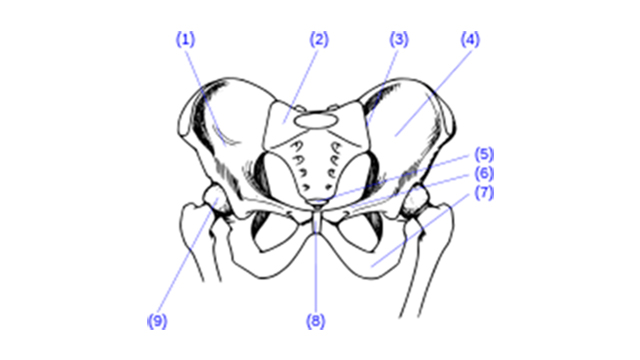
03 Feb Symphysis Pubis Dysfunction (SPD)
What is Pubis Symphysis Dysfunction (PSD), Symphysis Pubis Dysfunction (SPD)?
Symphysis Pubis Dysfunction (SPD) is a painful condition that occurs when there is excessive movement between the pubis bones at the front of the pelvis.
The Pelvis is made up of 4 separate bones; the Sacrum and Coccyx at the back and sides, and the 2 hip bones which curve around and meet at the front at a joint called Symphysis Pubis (SP) – see diagram. The function of the SP Joint is to hold the pelvis steady when we are using our legs and normally there is a 4-5 mm gap at the SP Joint.
The major components of the Pelvis
- Right Ilium
- Sacrum
- Sacroiliac Joint
- Left Ilium
- Coccyx
- Pubis
- Ischium
- Pubis Symphysis
- Femoral/Hip Joint
SPD is most commonly associated with pregnancy. During pregnancy the hormone Relaxin is released to soften the connecting ligaments around the joint to facilitate childbirth and it is usual for the gap to widen a further 2 – 3 mm. Sometimes the ligaments soften and stretch too much. The result is an exaggerated gap at that joint leading to instability and therefore pain. The SP Joint cannot do its job and strain is placed on other pelvic joints causing pain.
Ordinary activity such as walking, climbing stairs, standing, parting the legs to climb into a bath, getting in and out of a car or putting on underwear is very painful. The sufferer will experience pain in the pubic bone area at the front, groin, inside of the thighs, sometimes in the lower back and hips, may hear clicking or a grating sound when walking and in severe cases they will end up on crutches.
The best person to treat SPD is a Physiotherapist – preferably Obstetric, who may amongst other things offer you a support garment to wear.
Although SPD is most commonly associated with pregnant women, they are not the only sufferers. The external forces generated by high-impact injuries such as falling off a horse, car accidents, impact sports can also result in symphysis pubis dysfunction.
8 Top Tips for Easing Pubis Symphysis Dysfunction
- Keep active but avoid the activity which increases or causes you pain. BE SMART and MODIFY
- Avoid standing for long periods
- When standing do so with equal weight on both feet
- Climb up, and go down stairs one at a time
- Get into and out of a car like your granny taught you! Legs together like a lady!
- When turning over in bed or when preparing to get up – knees bent and together, tighten your core lift your pelvic floor before moving
- Think about your posture – avoid the pregnancy pose
- Strengthen your pelvic floor by doing Kegel Exercises
Can Pilates help with Symphysis Pubis Dysfunction?
Yes, with a well qualified instructor – Pilates will address Posture and good alignment, efficient breathing, pelvic floor and core strength as well specific exercises which are tailored towards pelvic stability and SPD.
I have guided many clients through pregnancy; in some cases 3rd and 4th pregnancies, several of whom have suffered with SPD. They have all gained great benefit from the Pilates Method and alleviation of the symptoms of SPD. The symptoms of SPD can persist after childbirth – if for a prolonged period (more than 6 -12 months) then medical advice should be sought.
Further Reading
To find out more about Kegel Exercises check Wikipedia
Keep Me Posted
If you have enjoyed reading this article, then why not sign up to receive new articles as they are released?Just let us know which subjects you are interested in, and we'll send you the details hot from the press.

